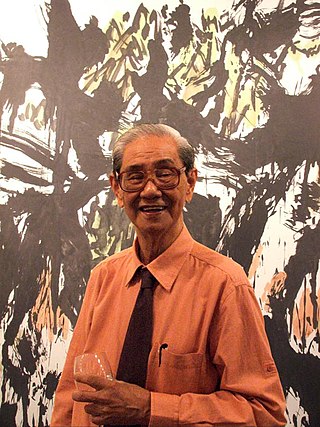Top Qs
Timeline
Chat
Perspective
Lim Tze Peng
Singaporean artist (1921–2025) From Wikipedia, the free encyclopedia
Remove ads
Lim Tze Peng DUBC PJG BBM PPA (Chinese: 林子平; pinyin: Lín Zǐpíng; Pe̍h-ōe-jī: Lîm Tsí-pîng, 28 September 1921 – 3 February 2025) was a Singaporean artist. He was awarded a Cultural Medallion in 2003 in recognition of his contribution to the country's art and culture. In June 2021, it was reported that he was still producing art at the age of 99.[1]
This article contains promotional content. (February 2025) |
Remove ads
Background
Lim Tze Peng (Lim Swee Lian) was born on 28 September 1921 in Singapore[2] to a family of pig and chicken farmers in Pasir Ris. He was the eldest of seven children.[3]
Lim studied at Guangyang Primary School and Chung Cheng High School (Main).[4]
In 1949, Lim became a primary school teacher at Xin Min School and then became principal in 1951.[4] He remained as principal until he retired in 1981.[4]
Lim was humble by nature, and went about in his quiet way doing what he loved best without fanfare. He was content to stay in the background, preferring his paintings speak for themselves. Lim was also an artist with a mission, and that mission was to remind Singaporeans of their heritage.[2]
Lim died of pneumonia in Singapore on 3 February 2025, at the age of 103.[5] He was posthumously awarded the Distinguished Service Order on 9 August 2025 for his contributions to Singapore's cultural heritage and visual arts landscape.[6]
Remove ads
Painting career
Summarize
Perspective
A self-taught artist, Lim was skilled in Chinese brush and calligraphy.[7] The only formal art training he had was the drawing classes he attended in his school days.[2] Lim started learning how to paint in his twenties and after his retirement, started to paint professionally.[3]
Lim opted for an early retirement from his job as a school principal in 1981 in order to spend his time painting scenes of the Singapore River, Boat Quay, Hock Lim Street, Merchant Road, Smith Street, Trengganu Street, Sago Lane, and Pagoda Street.[2]
Painting for Lim meant sketching on the spot with Chinese ink and brush. It was a total experience in that he took in what he saw and felt at a single moment in time, selecting, analysing, composing, and recording details simultaneously. His handling of tonal values and the swift notations of light and dark complemented the decisive brush strokes to give life and movement to the subject matter. The calligraphic brushwork, rooted in the artist's deep knowledge of Chinese writing, is the most characteristic feature of Lim's work.[2]
In 2003, Lim was awarded the Cultural Medallion and in 2016,[3] he was awarded the Pingat Jasa Gemilang (Meritorious Service Medal).[8]
Remove ads
Influences
Lim scrutinised the masterpieces of the leading Chinese artists in history. He was convinced that the power of their work often resided in one singular aspect which dominated their overall achievements. His observations are revealing: the visual power of Pan Tianshou's (1897–1971) paintings radiates from the massiveness of his expansive forms; that of Qi Baishi's (1863–1957) from his overpowering sensitivity of touch; that of Wu Changshou's (1844–1927) from his intriguing balance of the painterly dynamics in his art.
Works in Chinese art history impressed him, particularly those characterised by a tremendous sense of directness, the orthodox and liberation. He singled out Ming dynasty artists such as Xu Wei (1521–1593) and Qing dynasty artists such as Pu Huan (1832–1911), whose dynamic works remain as powerful as they are contemporary today.[9]
Old Singapore series
In 1981, Lim plunged into an uninterrupted marathon race to complete a large number of Singapore scenes which had captured his imagination. This feat produced 300 ink paintings, covering a range of places which included Teochew Street, Amoy Street, Chinatown, Elgin Bridge, shop houses and sweeping overviews of the Singapore River. The Old Singapore Series became a visual documentation of Singapore’s changing cityscape during a time when the country’s urban renewal was happening at a hectic pace.[9]
Remove ads
Artists' residency in Paris
In 2000, Lim took up a two-month artists' residency in the Cité internationale des arts, occupying an apartment belonging to the Nanyang Academy of Fine Arts (NAFA) in Singapore. His residency resulted in a body of works documenting the Parisian landscape, which included landmarks such as the Eiffel Tower, the Moulin Rouge, the Arc de Triomphe, and Notre-Dame de Paris as well as Parisian scenes of sidestreets and cafés.
He later donated 45 of these Chinese ink and colour paintings to NAFA. [10]
Remove ads
Major exhibitions
Summarize
Perspective
Remove ads
Awards
Bibliography
- Lim, Tze Peng (2007). 林子平:新加坡河的记忆 (Lim Tze Peng: Singapore River memory). Singapore: Cape of Good Hope Gallery.
- Chua, Chim Kang; Tan, Bridget Tracy, eds. (2003). Tze Peng. Singapore: Singapore Art Museum. ISBN 981-05-0094-7.
References
External links
Wikiwand - on
Seamless Wikipedia browsing. On steroids.
Remove ads

